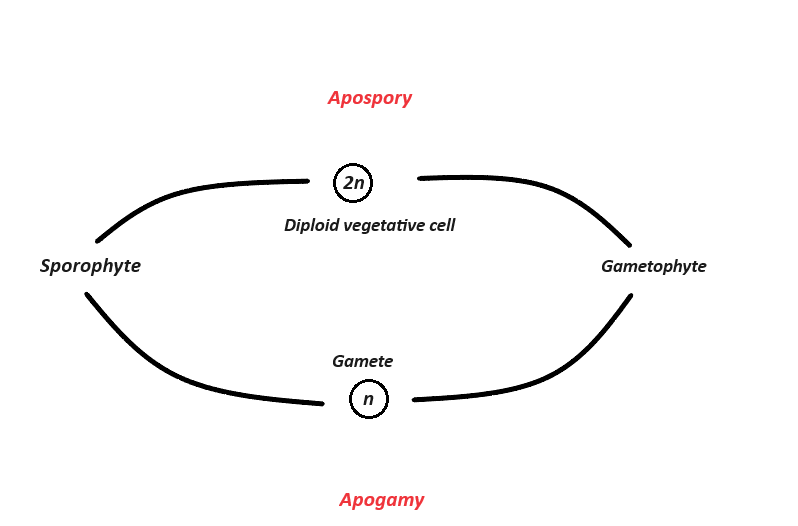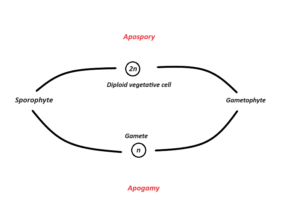
Apospory and apogamy are two types of asexual reproduction processes in plants. Most plants usually go through a life cycle where they switch between having one set of chromosomes (haploid) and two sets (diploid). However, in some cases, this cycle gets disrupted by two interesting things called apospory and apogamy. These disruptions mess with the usual pattern of chromosome changes in the life cycle of certain plants (Pteridophytes), making things a bit different from what we typically expect.
Apospory
Apospory is a fascinating deviation from the conventional life cycle of vascular plants, specifically in the context of pteridophytes. This phenomenon involves the development of gametophytes directly from the vegetative parts or cells of the sporophyte, bypassing the usual processes of meiotic division and spore formation. Unlike the typical haploid spores produced through meiosis, the gametophytes generated via apospory are diploid.
The discovery of apospory dates back to 1884 when Druery first observed it in Athyrium filix-foemina. Since then, this intriguing reproductive strategy has been identified in several other pteridophytes, including prominent species such as Pteridium aquilinum, Asplenium dimorphum, Osmunda regalis, and Todea. The fundamental departure from the conventional reproductive pathway adds a layer of complexity to our understanding of plant reproductive biology.
In apospory, the vegetative cells of the sporophyte undergo a specialized development process, giving rise to diploid gametophytes directly. This deviation challenges the classical view of the alternation of generations, where meiosis generates haploid spores that develop into gametophytes. The occurrence of apospory introduces a novel avenue for plant adaptation, potentially providing advantages in specific ecological contexts or under certain environmental pressures.
Understanding the molecular and genetic mechanisms underlying apospory is a frontier in plant biology research. Unraveling the intricate regulatory pathways and factors involved in the initiation and progression of apospory can shed light on the genetic basis of this phenomenon. Such insights have implications not only for understanding the diversity of plant reproductive strategies but also for potential applications in agriculture and horticulture.

Apogamy
Apogamy, another deviation from the norm in the life cycle of vascular plants, presents a unique twist in reproductive biology. This phenomenon involves the development of a sporophyte directly from the gametophyte, without the occurrence of gametes or sexual fusion (syngamy). The sporophyte resulting from apogamy retains the same haploid chromosome numbers as the original gametophyte, defying the typical alternation of generations seen in plant life cycles.
First discovered by Farlow in 1874 in Pteris cretica, apogamy has been identified as a common and widespread phenomenon in ferns. It has been reported in various fern species, including Pteris, Pteridim, Dryopteris, Adiantum, Osmunda, Todea, Athyrium, and Asplenium. The natural prevalence of apogamy in ferns underscores its significance in the evolutionary context of plant reproductive strategies.
The direct development of sporophytes from gametophytes in apogamy bypasses the intricate process of gamete formation and fusion. This departure from conventional sexual reproduction pathways may confer certain advantages to plants in specific ecological niches or under particular environmental conditions. Apogamy challenges our traditional understanding of the importance of sexual reproduction in maintaining genetic diversity and adaptability.
Research into the molecular and physiological mechanisms governing apogamy is a dynamic area of study within plant biology. Elucidating the genetic basis and regulatory networks involved in apogamous development can provide valuable insights into the evolutionary forces shaping plant reproductive strategies. Furthermore, the study of apogamy holds potential applications in horticulture and plant breeding, where a deeper understanding of alternative reproductive pathways could influence crop improvement strategies.
Read Also
- https://aliscience.in/pteridophyte-plants-common-features/
- https://aliscience.in/the-economic-importance-of-pteridophytes/
External Links
Here are some external links that provide more information on these topics:



